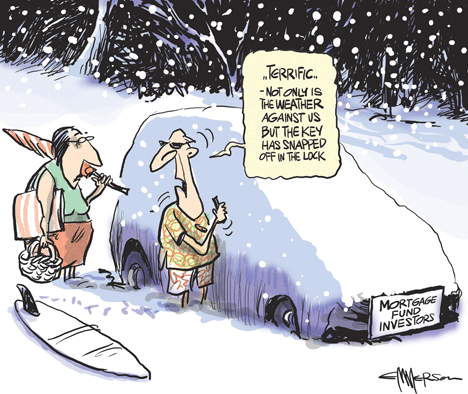Earlier this week, I posted the complaint filed by A.I.G. subsidiary United Guaranty Mortgage Indemnity Co. (UG) in federal court in Los Angeles. The Subprime Shakeout has now obtained the complaint that started this battle of mortgage industry titans, filed by Countrywide on March 18, 2009 in Los Angeles County Superior Court.
The complaint, also embedded below, alleges that UG refused to pay claims by Countrywide on losses covered under the terms of its insurance policies. Countrywide seeks declaratory relief, compensatory damages based on breach of contract and punitive damages breach of the implied covenant of good faith and fair dealing.
A few observations about this dispute:
- Removal: The first major battle in this case will likely be over the removability ofCountrywide’s state court action. As UG has brought a related action in federal court in Los Angeles (based on diversity jurisdiction), it will likely remove Countrywide’s action to federal court and attempt to consolidate the actions. Countrywide, apparently anticipating this move, has named Countrywide Servicing LP as a plaintiff and alleged that the entity is a North Carolina citizen, making it non-diverse from UG (also a North Carolina entity). While Countrywide Servicing is organized under the laws of Texas and has its principal place of business there, Countrywide argues that Countrywide Servicing is a citizen of North Carolina because the General Partner and Limited Partner of Countrywide Servicing (neither of which, incidentally, are organized under the laws of North Carolina) “are citizens of North Carolina, as their sole owner/member is Bank of America,” which has its main office in North Carolina. This is one of the most convoluted attempts to destroy complete diversity that I’ve seen, and it seems unlikely that Countrywide will succeed in having the case remanded to state court.
- Loss Causation: Countrywide, like UG, confronts the loss causation issue head-on, arguing that it’s been conducting its lending operations in the same manner that it has for years, and that UG is only complaining now that the housing market has collapsed and the country is in a “deep economic recession” (see pages 24-25). Though Countrywide maintains that “[t]he increase of defaults is not limited to loans originated by Countrywide, but is a phenomenon occurring nationwide and has impacted all mortgage lenders” (page 25(emphasis added)), it is unclear whether the absolute default rates on the pools of Countrywide loans at issue here are greater than comparable pools. Countrywide maintains that they are (at pages 26-27), but such numbers can be manipulated depending on the pools chosen as “comparable.” UG would be wise to further develop its allegations and supporting evidence in this regard if it hopes to refute Countrywide’s contention that the market, not Countrywide, caused UG’s losses.
- Sophistication: Another interesting dichotomy set up by these two complaints is the sophistication of UG in insuring subprime mortgage loans. While UG argued in its complaint that “[p]rior to 2006, United Guaranty had very limited experience insuring subprime mortgage loans,” (see UG Complaint, page 14) Countrywide argues that UG, “is a sophisticated market actor in this area” (see Countrywide Complaint, page 17). Countrywide goes to great lengths to show that UG understood the risks it was undertaking, quoting such diverse sources as the Mortgage Insurance Companies of America (page 18), an article by Robert Stowe in which a UG executive is quoted (page 19), and an AIG Mortgage Industry Presentation (page 20). Ultimately, however, this dispute will boil down to whether Countrywide followed its stated guidelines or not. If it did not, it will be difficult to argue that UG assumed the risk.
- AIG’s Financial Condition: As support for its claims of bad faith and unjustified denial of coverage under the policies, Countrywide includes allegations about AIG’s and UG’s “deteriorating financial condition” (page 29) and contends that UG is unlikely to receive any financial support from its parent, AIG. Countrywide thus argues that it, “has justifiable cause to believe that United Guaranty’s recent decision to stop the payment of otherwise covered claims may be related to its financial condition and the financial condition of AIG and its affiliates, rather than to the merits of whether particular claims should be paid” (page 31). Countrywide further alleges that the only justification provided thus far by UG for its refusal to pay coverage is that “it has already paid too much” (page 28). While this line of argument may provide effective coloring or “atmospherics” underlying the suit for a judge or jury, UG has likely provided sufficient justification in its complaint for its refusal, in the form of its allegations regarding Countrywide’s deficient underwriting, to overcome Countrywide’s bad faith argument. However, the specter of bad faith must be cause for some concern at UG, especially if the claim mak
es it past the summary judgment stage. Given UG’s tenuous financial position and its unorthodox approach of wholesale refusal to pay claims on any loans contained in the subject securitizations, regardless of individual loan characteristics, it is conceivable that a judge or jury could conclude that UG unreasonably denied coverage for the purpose of using the money elsewhere. And a punitive damages award against one of its subsidiaries is just about the last thing AIG needs in this political and financial climate.
Countrywide v. UG Complaint





